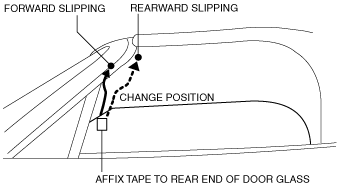 |
amxuuw00005495
DOOR GLASS REVERSE OPENS DURING MANUAL-CLOSE OPERATION (MIS REVERSE OPEN) [POWER WINDOW SYSTEM]
id0903a0552000
|
Description
|
Door glass reverse opens during auto-close
|
|
Possible Causes
|
• Extreme change in the sliding resistance of the glass while the door glass is closing.
|
Diagnostic procedure
|
STEP |
INSPECTION |
ACTION |
|
|---|---|---|---|
|
1
|
INSPECT MALFUNCTION SYMPTOM
• Inspect malfunction symptom.
• Does the malfunction symptom occur only under the following special conditions?:
|
Yes
|
The system is normal.
(Explain to the customer that this does not indicate a malfunction because the system is designed to reverse the door glass while it is closing if it receives vibration when the vehicle is crossing railroad tracks, driving on a bumpy road, or when the door is opened/closed.)
|
|
No
|
Go to the next step.
|
||
|
2
|
VERIFY DOOR GLASS OPERATION
• Inspect door glass closing speed.
• Affix tape to the rear edge of the door glass as shown in the figure for placing marks. (to facilitate seeing the door glass movement)
• Start the engine and idle it (to ensure a stabilized operational voltage).
• Does the door glass hesitate only once while its closing?
|
Yes
|
Mark the point where the door glass closing speed changed, then go to Step 4.
|
|
No
|
Go to the next step.
|
||
|
3
|
VERIFY DOOR GLASS OPERATION
• Reinspect door glass closing speed.
• Does the door glass hesitate periodically while it is closing?
|
Yes
|
Replace the power window motor, then go to Step 9.
|
|
No
|
Go to Step 9.
|
||
|
4
|
DETERMINE IF MALFUNCTIONING LOCATION IS GLASS RUN CHANNEL
• Inspect glass run channel and door glass sliding surface.
• Visually inspect the sliding surface of the glass run channel and door glass.
• Is there foreign matter penetration or roughness on the sliding surface (rubber surface)?
|
Yes
|
If there is foreign matter penetration
• Remove the foreign matter.
Roughness on the sliding surface (rubber surface):
• Replace the glass run channel.
After performing one of the above actions, reinspect.
If the malfunction has not been resolved, repeat the inspection from Step 2.
|
|
No
|
Go to the next step.
|
||
|
5
|
DETERMINE IF MALFUNCTIONING LOCATION IS WEATHERSTRIP, FRONT BELTLINE MOLDING
• Inspect the sliding surface of the weatherstrip, front beltline molding, and door glass.
• Is there foreign matter penetration or roughness on the sliding surface (rubber surface)?
|
Yes
|
If there is foreign matter penetration
• Remove the foreign matter.
Roughness on the sliding surface (rubber surface):
• Replace the weatherstrip or front beltline molding.
After performing one of the above actions, reinspect.
If the malfunction has not been resolved, repeat the inspection from Step 2.
|
|
No
|
Go to the next step.
|
||
|
6
|
VERIFY DOOR GLASS INSTALLATION CONDITION
• Inspect tightening of door glass to carrier plate.
• Is it normal?
|
Yes
|
Go to the next step.
|
|
No
|
After tightening correctly, reinspect.
If the malfunction has not been resolved, repeat the inspection from Step 2.
|
||
|
7
|
VERIFY ASSEMBLY CONDITION OF GLASS RUN CHANNEL AND GLASS GUIDE
• Inspect condition of glass run channel and door glass.
• Is it normal?
|
Yes
|
Go to the next step.
|
|
No
|
Assemble the glass run channel and door glass securely, and reinspect.
If the malfunction has not been resolved, repeat the inspection from Step 2.
|
||
|
8
|
VERIFY ASSEMBLY CONDITION OF WEATHERSTRIP AND FRONT BELTLINE MOLDING
• Inspect condition of weatherstrip and front beltline molding.
• Is it normal?
|
Yes
|
Go to the next step.
|
|
No
|
Assemble the weatherstrip and front beltline molding, and reinspect.
If the malfunction has not been resolved, repeat the inspection from Step 2.
|
||
|
9
|
VERIFY DOOR GLASS OPERATION
• Inspect door glass closing speed.
• Does the door glass hesitate at any location?
|
Yes
|
Repeat the inspection from Step 2.
|
|
No
|
Troubleshooting completed.
|
||
amxuuw00005495
|